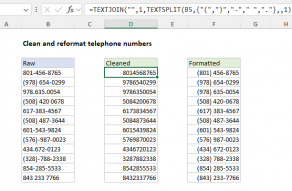Explanation
The formula shown in this example uses a series of nested SUBSTITUTE functions to strip out parentheses, hyphens, colons, semi-colons, exclamation marks, commas, and periods. The process runs from the inside out, with each SUBSTITUTE replacing one character with a single space, then handing off to the next SUBSTITUTE. The inner most SUBSTITUTE removes the left parentheses, and the result is handed to the next SUBSTITUTE, which removes the right parentheses, and so on.
In the version below, line breaks have been added for readability, and to make it easier to edit replacements. Excel does not care about line breaks in formulas, so you can use the formula as-is.
=
LOWER(
TRIM(
SUBSTITUTE(
SUBSTITUTE(
SUBSTITUTE(
SUBSTITUTE(
SUBSTITUTE(
SUBSTITUTE(
SUBSTITUTE(
SUBSTITUTE(
A1,
"("," "),
")"," "),
"-"," "),
":"," "),
";"," "),
"!"," "),
","," "),
"."," ")))
After all substitutions are complete, the result is run through TRIM to normalize spaces, then the LOWER function to force all text to lowercase.
Note: You'll need to adjust the actual replacements to suit your data.
Adding a leading and trailing space
In some cases you may want to add a space character to the start and end of the cleaned text. For example, if you want to count words precisely, you may want to look for the word surrounded by spaces (i.e. search for " fox ", " map ") to avoid false matches. To add a leading and trailing space, just concatenate a space (" ") to the start and end:
=" "&formula&" "
Where "formula" is the longer formula above.














